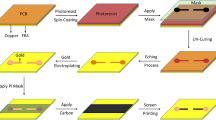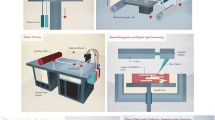Abstract
This paper reports a novel 3D-printed fluidic valve which is fabricated by projection-stereolithography (PSL) in combination with insertion of functional elements such as permanent magnets. We first constructed a PSL setup which can fabricate complicated three dimensional structures via layer-by-layer photocuring. Then, 3D fluidic valves which could be remotely controlled were designed. After the working mechanisms of proposed fluidic valves were thoroughly analyzed, they were fabricated with outlet orifice diameters of 0.5, 1, and 2 mm. The main housing of the valve assembly was printed, then, three permanent magnets were inserted into the part and the valve fabrication was completed by combining the end cap with an orifice and sealing. The completed valve was integrated within a 20-Fr (6.7-mm in diameter) medical catheter for evaluation. The flow rate through the valve could be controlled by changing positions of the inserted permanent magnets with an external magnetic field. With the applied pressure of 10 kPa, the flow rate was measured to be 131.07 mL/min that is only 8.78% lower than the system without the valve (143.68 mL/min). The results obtained in this work would be beneficial to further development of efficient fluidic valves for complicated 3D fluidic systems.
Similar content being viewed by others
References
Xia, Y. and Whitesides, G. M., “Soft Lithography,” Annual Review of Materials Science, Vol. 28, No. 1, pp. 153–184, 1998.
Go, J. S. and Shoji, S., “A Disposable, Dead Volume-Free and Leak-Free In-Plane PDMS Microvalve,” Sensors and Actuators A: Physical, Vol. 114, No. 2, pp. 438–444, 2004.
Jeong, O. C. and Konishi, S., “Fabrication and Drive Test of Pneumatic PDMS Micro Pump,” Sensors and Actuators A: Physical, Vol. 135, No. 2, pp. 849–856, 2007.
Lee, K., Kim, C., Shin, K. S., Lee, J. W., Ju, B.-K., et al., “Fabrication of Round Channels using the Surface Tension of PDMS and Its Application to a 3D Serpentine Mixer,” Journal of Micromechanics and Microengineering, Vol. 17, No. 8, pp. 1533, 2007.
Haeberle, S. and Zengerle, R., “Microfluidic Platforms for Lab-ona-Chip Applications,” Lab on a Chip, Vol. 7, No. 9, pp. 1094–1110, 2007.
Zhang, M., Wu, J., Wang, L., Xiao, K., and Wen, W., “A Simple Method for Fabricating Multi-Layer PDMS Structures for 3D Microfluidic Chips,” Lab on a Chip, Vol. 10, No. 9, pp. 1199–1203, 2010.
Choi, J.-W., Medina, F., Kim, C., Espalin, D., Rodriguez, D., et al., “Development of a Mobile Fused Deposition Modeling System with Enhanced Manufacturing Flexibility,” Journal of Materials Processing Technology, Vol. 211, No. 3, pp. 424–432, 2011.
Shallan, A. I., Smejkal, P., Corban, M., Guijt, R. M., and Breadmore, M. C., “Cost-Effective Three-Dimensional Printing of Visibly Transparent Microchips Within Minutes,” Analytical Chemistry, Vol. 86, No. 6, pp. 3124–3130, 2014.
Comina, G., Suska, A., and Filippini, D., “PDMS Lab-on-a-Chip Fabrication using 3D Printed Templates,” Lab on a Chip, Vol. 14, No. 2, pp. 424–430, 2014.
Kitson, P. J., Rosnes, M. H., Sans, V., Dragone, V., and Cronin, L., “Configurable 3D-Printed Millifluidic and Microfluidic ‘Lab on a Chip’Reactionware Devices,” Lab on a Chip, Vol. 12, No. 18, pp. 3267–3271, 2012.
Symes, M. D., Kitson, P. J., Yan, J., Richmond, C. J., Cooper, G. J., et al., “Integrated 3D-Printed Reactionware for Chemical Synthesis and Analysis,” Nature Chemistry, Vol. 4, No. 5, pp. 349–354, 2012.
Comina, G., Suska, A., and Filippini, D., “Low Cost Lab-on-a-Chip Prototyping with a Consumer Grade 3D Printer,” Lab on a Chip, Vol. 14, No. 16, pp. 2978–2982, 2014.
Martino, C., Berger, S., and Wootton, R. C., “A 3D-Printed Microcapillary Assembly for Facile Double Emulsion Generation,” Lab on a Chip, Vol. 14, No. 21, pp. 4178–4182, 2014.
Olcum, S., Cermak, N., Wasserman, S. C., Christine, K. S., Atsumi, H., et al., “Weighing Nanoparticles in Solution at the Attogram Scale,” Proceedings of the National Academy of Sciences, Vol. 111, No. 4, pp. 1310–1315, 2014.
Anderson, K. B., Lockwood, S. Y., Martin, R. S., and Spence, D. M., “A 3D Printed Fluidic Device that Enables Integrated Features,” Analytical Chemistry, Vol. 85, No. 12, pp. 5622–5626, 2013.
Dendukuri, D., Pregibon, D. C., Collins, J., Hatton, T. A., and Doyle, P. S., “Continuous-Flow Lithography for High-Throughput Microparticle Synthesis,” Nature Materials, Vol. 5, No. 5, pp. 365–369, 2006.
Miserendino, S. and Tai, Y.-C., “Modular Microfluidic Interconnects using Photodefinable Silicone Microgaskets and MEMS O-Rings,” Sensors and Actuators A: Physical, Vol. 143, No. 1, pp. 7–13, 2008.
Murphy, E. R., Inoue, T., Sahoo, H. R., Zaborenko, N., and Jensen, K. F., “Solder-based Chip-to-Tube and Chip-to-Chip Packaging for Microfluidic Devices,” Lab on a Chip, Vol. 7, No. 10, pp. 1309–1314, 2007.
Paydar, O. H., Paredes, C. N., Hwang, Y., Paz, J., Shah, N. B., and Candler, R. N., “Characterization of 3D-Printed Microfluidic Chip Interconnects with Integrated O-Rings,” Sensors and Actuators A: Physical, Vol. 205, pp. 199–203, 2014.
Rupitsch, S. J., Ilg, J., Sutor, A., Lerch, R., and Döllinger, M., “Simulation based Estimation of Dynamic Mechanical Properties for Viscoelastic Materials Used for Vocal Fold Models,” Journal of Sound and Vibration, Vol. 330, No. 18, pp. 4447–4459, 2011.
Vokoun, D., Beleggia, M., Heller, L., and Šittner, P., “Magnetostatic Interactions and Forces between Cylindrical Permanent Magnets,” Journal of magnetism and Magnetic Materials, Vol. 321, No. 22, pp. 3758–3763, 2009.
Figliola, R. S. and Beasley, D., “Theory and Design for Mechanical Measurements,” John Wiley & Sons, 5th Ed., pp. 98–102, 2010.
Author information
Authors and Affiliations
Corresponding authors
Rights and permissions
About this article
Cite this article
Kim, S., Lee, J. & Choi, B. 3D printed fluidic valves for remote operation via external magnetic field. Int. J. Precis. Eng. Manuf. 17, 937–942 (2016). https://doi.org/10.1007/s12541-016-0114-9
Received:
Accepted:
Published:
Issue Date:
DOI: https://doi.org/10.1007/s12541-016-0114-9




